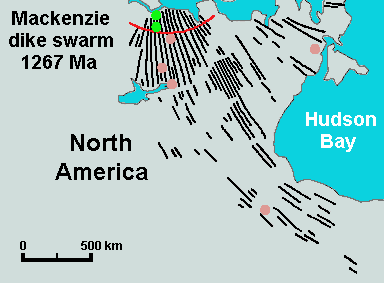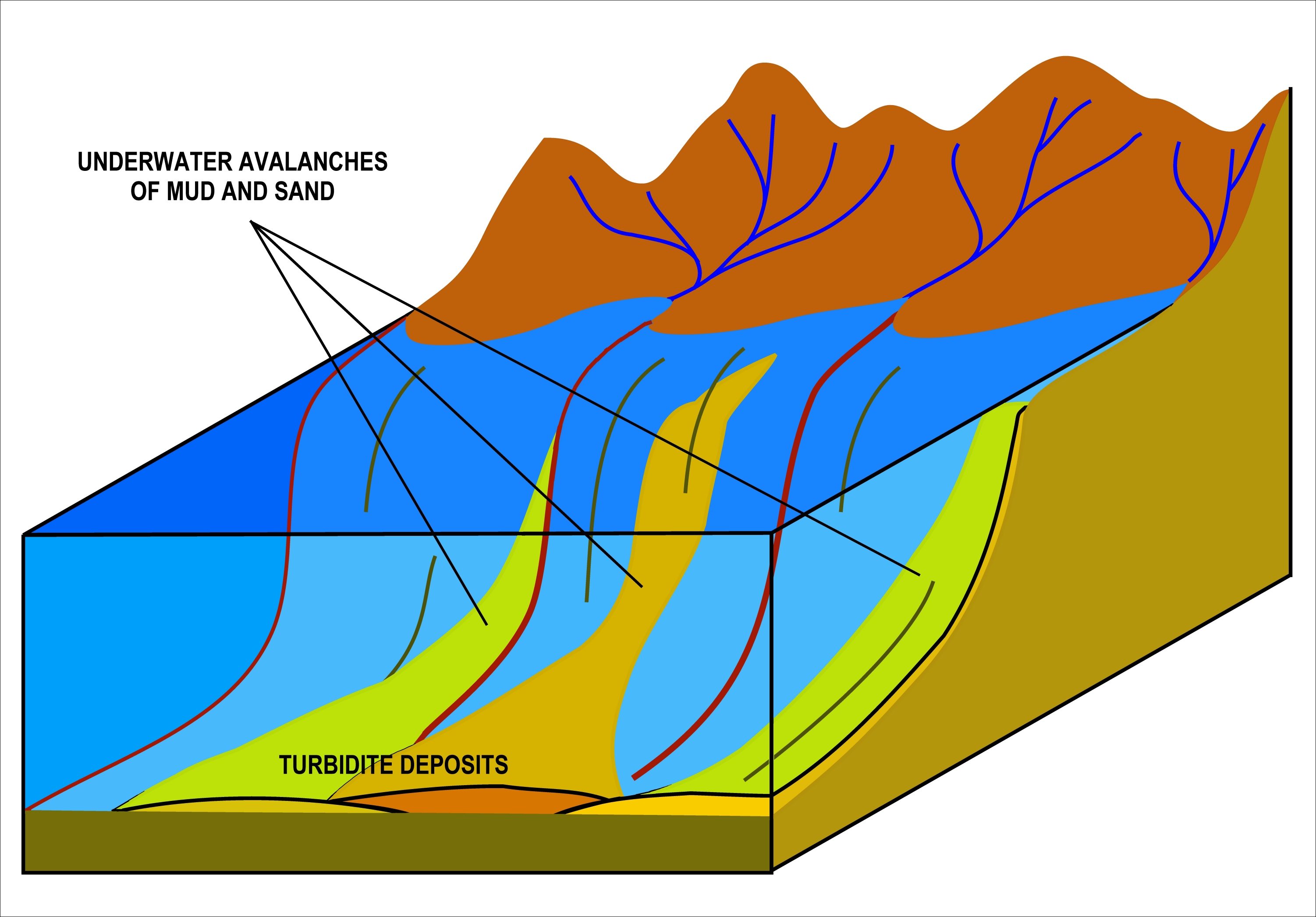|
Back River Volcanic Complex
The Back River volcanic complex is an Archean stratovolcano spanning the Northwest Territories–Nunavut border in Northern Canada. It is located northwest of Yellowknife and to the northwest of the Back River from which it takes its name. The volcano constitutes the Back Group of the Yellowknife Supergroup and is somewhat anomalous in the Slave craton because it has undergone only a low degree of deformation and is subhorizontal. The southern half of the complex is exposed at the crest of a small dome. This is the eroded portion of the stratovolcano that has been preserved in an upright position. The complex comprises four volcanic sedimentary sequences (Innerring, Thlewyco, Boucher-Regan, Kelsh) that correspond to the phases of growth and destruction of this stratovolcano. Innerring The Innerring sequence, which constitutes the oldest rocks of the complex, represents the upper part of an eroded early phase of the volcano (U-Pb zircon igneous age of 2.708 Gigaannum (Ga)). T ... [...More Info...] [...Related Items...] OR: [Wikipedia] [Google] [Baidu] |
Stratovolcano
A stratovolcano, also known as a composite volcano, is a typically conical volcano built up by many alternating layers (strata) of hardened lava and tephra. Unlike shield volcanoes, stratovolcanoes are characterized by a steep profile with a summit crater and explosive eruptions. Some have collapsed summit craters called calderas. The lava flowing from stratovolcanoes typically cools and solidifies before spreading far, due to high viscosity. The magma forming this lava is often felsic, having high to intermediate levels of silica (as in rhyolite, dacite, or andesite), with lesser amounts of less viscous mafic magma. Extensive felsic lava flows are uncommon, but can travel as far as 8 km (5 mi). The term ''composite volcano'' is used because strata are usually mixed and uneven instead of neat layers. They are among the most common types of volcanoes; more than 700 stratovolcanoes have erupted lava during the Holocene Epoch (the last 11,700 years), and many ol ... [...More Info...] [...Related Items...] OR: [Wikipedia] [Google] [Baidu] |
Dacite
Dacite () is a volcanic rock formed by rapid solidification of lava that is high in silica and low in alkali metal oxides. It has a fine-grained (aphanitic) to porphyritic texture and is intermediate in composition between andesite and rhyolite. It is composed predominantly of plagioclase feldspar and quartz. Dacite is relatively common, occurring in many tectonic settings. It is associated with andesite and rhyolite as part of the subalkaline tholeiitic and calc-alkaline magma series. Etymology The word ''dacite'' comes from Dacia, a province of the Roman Empire which lay between the Danube River and Carpathian Mountains (now modern Romania and Moldova) where the rock was first described. The term ''dacite'' was used for the first time in the scientific literature in the book ''Geologie Siebenbürgens'' (''The Geology of Transylvania'') by Austrian geologists Franz Ritter von Hauer and Guido Stache. Dacite was originally defined as a new rock type to separate calc-alkaline ... [...More Info...] [...Related Items...] OR: [Wikipedia] [Google] [Baidu] |
Volcanoes Of Nunavut
A volcano is commonly defined as a vent or fissure in the crust of a planetary-mass object, such as Earth, that allows hot lava, volcanic ash, and gases to escape from a magma chamber below the surface. On Earth, volcanoes are most often found where tectonic plates are diverging or converging, and because most of Earth's plate boundaries are underwater, most volcanoes are found underwater. For example, a mid-ocean ridge, such as the Mid-Atlantic Ridge, has volcanoes caused by divergent tectonic plates whereas the Pacific Ring of Fire has volcanoes caused by convergent tectonic plates. Volcanoes resulting from divergent tectonic activity are usually non-explosive whereas those resulting from convergent tectonic activity cause violent eruptions."Mid-ocean ridge tectonics, volcanism and geomorphology." Geology 26, no. 455 (2001): 458. https://macdonald.faculty.geol.ucsb.edu/papers/Macdonald%20Mid-Ocean%20Ridge%20Tectonics.pdf Volcanoes can also form where there is stretching an ... [...More Info...] [...Related Items...] OR: [Wikipedia] [Google] [Baidu] |
Geological Survey Of Canada
The Geological Survey of Canada (GSC; , CGC) is a Canadian federal government agency responsible for performing geological surveys of the country developing Canada's natural resources and protecting the environment. A branch of the Earth Sciences Sector of Natural Resources Canada, the GSC is the country's oldest scientific agency and was one of its first government organizations. History In September 1841, the Province of Canada legislature passed a resolution that authorized the sum of £1,500 sterling be granted to the government for the estimated expense of performing a geological survey of the province. In 1842, the Geological Survey of Canada was formed to fulfill this request.Christy Vodden (1992)No Stone Unturned: The First 150 years of the Geological Survey of Canada Geological Survey of Canada Web site William Edmond Logan was in Montreal at the time and made it known that he was interested in participating in this survey. Gaining recommendations from prominent ... [...More Info...] [...Related Items...] OR: [Wikipedia] [Google] [Baidu] |
List Of Volcanoes In Canada
List of volcanoes in Canada is an incomplete list of volcanoes found in Geography of Canada, mainland Canada, in the Islands of Canada, Canadian islands and in Canadian waters. All but two Provinces of Canada, provinces, Prince Edward Island and Manitoba, have at least one volcano. Alberta British Columbia New Brunswick Newfoundland and Labrador Northwest Territories Nova Scotia Nunavut Ontario Quebec Saskatchewan Yukon See also * Outline of Canada * Bibliography of Canada * Index of Canada-related articles * Volcanism of Canada ** Volcanism of Northern Canada ** Volcanism of Western Canada ** Volcanism of Eastern Canada ** List of Northern Cordilleran volcanoes * List of mountains in Canada * List of Cascade volcanoes External links Catalogue of Canadian Volcanoes {{Canadian volcanism Volcanoes of Canada, Lists of volcanoes, Canada Lists of mountains of Canada, Volcanoes Lists of landforms of Canada, Volcanoes Canada geology-related li ... [...More Info...] [...Related Items...] OR: [Wikipedia] [Google] [Baidu] |
Volcanism Of Northern Canada
Volcanism in Northern Canada has produced hundreds of volcanic areas and extensive lava formations across Northern Canada. The region's different volcano and lava types originate from different tectonic settings and types of volcanic eruptions, ranging from passive lava eruptions to violent explosive eruptions. Northern Canada has a record of very large volumes of magmatic rock called large igneous provinces. They are represented by deep-level plumbing systems consisting of giant dike swarms, sill provinces and layered intrusions. Plume and rift complexes Vast volumes of basaltic lava covered Northern Canada in the form of a flood basalt event 1,267 million years ago that engulfed the landscape near the Coppermine River southwest of Coronation Gulf in the Canadian Arctic. This volcanic activity built an extensive lava plateau and large igneous province with an area of representing a volume of lavas of at least . With an area of and a volume of , it is larger than the Colu ... [...More Info...] [...Related Items...] OR: [Wikipedia] [Google] [Baidu] |
Volcanism Of Canada
Volcanic activity is a major part of the geology of Canada and is characterized by many types of volcanic landform, including lava flows, volcanic plateaus, lava domes, cinder cones, stratovolcanoes, shield volcanoes, submarine volcanoes, calderas, diatremes, and maars, along with less common volcanic forms such as tuyas and subglacial mounds. Though Canada's volcanic history dates back to the Precambrian eon, at least 3.11 billion years ago, when its part of the North American continent began to form, volcanism continues to occur in Western and Northern Canada in modern times, where it forms part of an encircling chain of volcanoes and frequent earthquakes around the Pacific Ocean called the Pacific Ring of Fire. Because volcanoes in Western and Northern Canada are in relatively remote and sparsely populated areas and their activity is less frequent than with other volcanoes around the Pacific Ocean, Canada is commonly thought to occupy a gap in the Ring of Fire between t ... [...More Info...] [...Related Items...] OR: [Wikipedia] [Google] [Baidu] |
Turbidite
A turbidite is the geologic Deposition (geology), deposit of a turbidity current, which is a type of amalgamation of fluidal and sediment gravity flow responsible for distributing vast amounts of clastic sediment into the deep ocean. Sequencing Turbidites were first properly described by Arnold H. Bouma (1962), who studied deepwater sediments and recognized particular "fining-up intervals" within deep water, fine-grained shales, which were anomalous because they started at pebble Conglomerate (geology), conglomerates and terminated in shales. This was anomalous because within the deep ocean it had historically been assumed that there was no mechanism by which tractional flow could carry and deposit coarse-grained sediments into the abyssal depths. Bouma sequence, Bouma cycles begin with an erosional contact of a coarse lower bed of pebble to granule conglomerate in a sandy matrix, and grade up through coarse then medium plane parallel sandstone; through cross-bedded sandstone; ... [...More Info...] [...Related Items...] OR: [Wikipedia] [Google] [Baidu] |
Detrital Zircon Geochronology
Detrital zircon geochronology is the science of geochronology, analyzing the age of zircons deposited within a specific sedimentary rock, sedimentary unit by examining their inherent radioisotopes, most commonly the uranium–lead dating, uranium–lead ratio. Zircon is a common Accessory mineral, accessory or trace mineral constituent of most granite and felsic igneous rocks. Due to its hardness, durability and chemical inertness, zircon persists in sedimentary deposits and is a common constituent of most sands. Zircons contain trace amounts of uranium and thorium and can be dated using several modern analytical techniques. Detrital zircon geochronology has become increasingly popular in geological studies from the 2000s mainly due to the advancement in radiometric dating techniques. Detrital zircon age data can be used to constrain the maximum depositional age, determine provenance (geology), provenance, and reconstruct the tectonic setting on a regional scale. Detrital zirco ... [...More Info...] [...Related Items...] OR: [Wikipedia] [Google] [Baidu] |
Yellowknife Greenstone Belt
The Yellowknife greenstone belt, also called the Yellowknife Volcanic Belt, is an Archean greenstone belt in the southern Slave craton, Northwest Territories, Canada. It is mostly made of mafic volcanic rocks (basalt and andesite) and is bordered to the east by batholithic intrusions of the Western Granodiorite Complex and beyond to the north by the Duckfish Lake Granite. Intrusive equivalents (gabbro and diorite) are collectively known as the Kam Group. Most of the Yellowknife townsite and the Con and Giant gold mines are within the Kam Group. The Yellowknife greenstone belt stands out as a positive topographic feature. See also *List of volcanoes in Canada *Volcanism of Canada *Volcanism of Northern Canada *Geography of the Northwest Territories *List of greenstone belts This is a list of greenstone belts Africa Burkina Faso * Hounde greenstone belt * Boromo greenstone belt Democratic Republic of the Congo *Kilo-Moto Angola * Lufico - Cabinda *Cassinga South Africa *Bar ... [...More Info...] [...Related Items...] OR: [Wikipedia] [Google] [Baidu] |
Kam Group
The Kam Group is a thick Archean volcanic group in the Yellowknife greenstone belt of the Northwest Territories, Canada. It consists of tholeiitic mafic and subordinate felsic volcanic rocks that were erupted in a submarine environment about 2706 million years ago. See also *List of volcanoes in Canada *Volcanism of Canada *Volcanism of Northern Canada ReferencesGeochemistry of the Archean Kam Group, Yellowknife Greenstone Belt, Slave Province, Canada {{Canada-geology-stub Volcanic groups Volcanoes of the Northwest Territories Archean volcanism ... [...More Info...] [...Related Items...] OR: [Wikipedia] [Google] [Baidu] |






